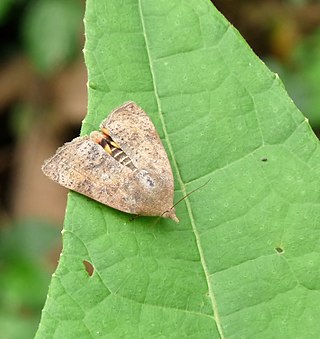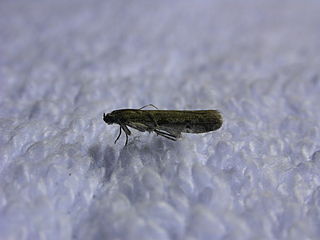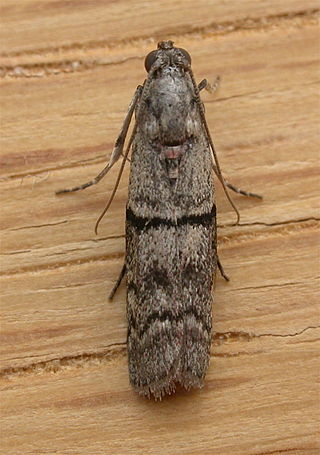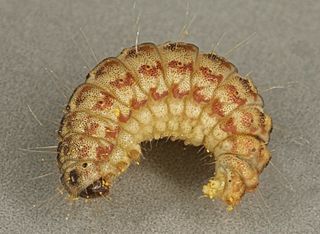
The Pyraloidea are a moth superfamily containing about 16,000 described species worldwide, and probably at least as many more remain to be described. They are generally fairly small moths, and as such, they have been traditionally associated with the paraphyletic Microlepidoptera.

Hyblaeidae are the "teak moths", a family of insects in the Lepidopteran order. The two genera with about 18 species make up one of the two families of the Hyblaeoidea superfamily, which in the past has been included in the Pyraloidea. Recent phylogenetic studies find varying relationships of Hyblaeoidea among Ditrysian Lepidoptera: Mutanen et al. (2010) find the superfamily to group either with Pyraloidea, or – more often – with Thyridoidea or butterflies. The results of Wahlberg et al. (2013) and Heikilä et al. (2015) indicate a sister-group relationship with Pyraloidea.

Spilomelinae is a very species-rich subfamily of the lepidopteran family Crambidae, the crambid snout moths. With 4,135 described species in 344 genera worldwide, it is the most speciose group among pyraloids.

Udea is a genus of snout moths in the subfamily Spilomelinae of the family Crambidae. The genus was erected by Achille Guenée in 1845. The currently known 215 species are present on all continents except Antarctica. About 41 species are native to Hawaii.

Phycitodes reliquella is a moth of the family Pyralidae described by Harrison Gray Dyar Jr. in 1904. It is known from North America where it is widely distributed in the east, including Alabama, Arkansas, Connecticut, the District of Columbia, Florida, Georgia, Illinois, Louisiana, Massachusetts, Maryland, Maine, North Carolina, New Hampshire, New Jersey, New York, Ohio, Oklahoma, Pennsylvania, South Carolina, Virginia and Ontario.

The Phycitini are a tribe of moths of the family Pyralidae.

Rhodophaea formosa is a moth of the family Pyralidae. It is found in most of Europe.

Phycitodes is a genus of snout moths described by George Hampson in 1917.

Phycitodes albatella is a species of snout moth. It is found in most of Europe, Uzbekistan and North America.

Phycitodes binaevella is a species of snout moth described by Jacob Hübner in 1813. It is found in most of Europe, Asia Minor, Lebanon and the Palestinian Territories.
Phycitodes inquinatella is a species of snout moth. It is found in most of Europe, the Canary Islands, Turkey and the Palestinian Territories.

Phycitodes lacteella is a species of snout moth first described by Walter Rothschild in 1915. It is found in most of Europe, Algeria, Morocco and Turkey.

Phycitodes maritima is a species of snout moth. It is found in most of Europe.

Phycitodes saxicola, the small clouded knot-horn, is a species of snout moth described by Vaughan in 1870. It is found in most of Europe, as well as Iran, Morocco and the Canary Islands.

Phycitodes subcretacella is a species of snout moth. It was described from Japan, but is also found in Spain and Russia.
Phycitodes gallicella is a species of snout moth which is endemic to France.

Glaphyriinae is a subfamily of the lepidopteran family Crambidae. It was described by William Trowbridge Merrifield Forbes in 1923. The subfamily currently comprises 509 species in 75 genera.

Scopariinae is a subfamily of the lepidopteran family Crambidae. The subfamily was described by Achille Guenée in 1854.

Lineodini is a tribe of the species-rich subfamily Spilomelinae in the snout moth family Crambidae.














